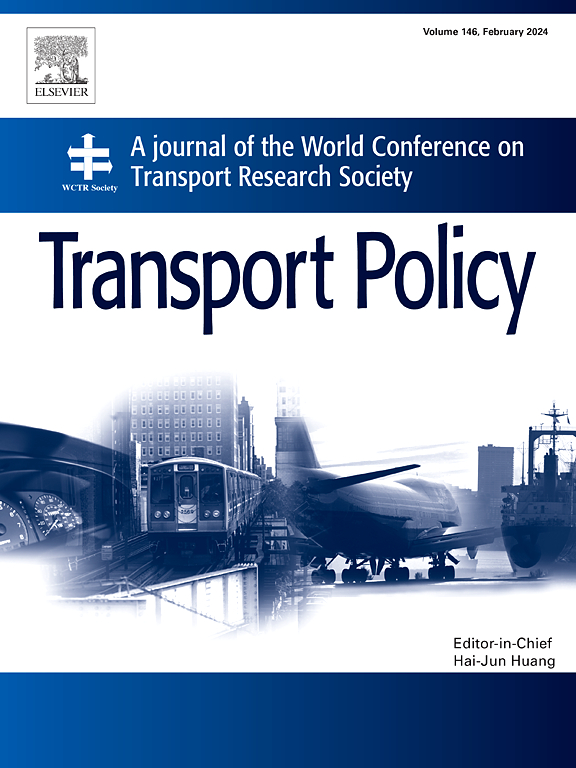电动汽车基础设施发展的早期政策制定:关键过程、考虑因素和优先事项
IF 6.3
2区 工程技术
Q1 ECONOMICS
引用次数: 0
摘要
随着政府和行业推进政策举措,鼓励基础设施发展以支持电动汽车的部署,电动汽车政策研究继续蓬勃发展。本研究补充了现有电动汽车政策特征和/或评估其影响的大量研究,为地方一级电动汽车基础设施发展的政策制定提供了思路。我们的研究强调了地方政府和公用事业公司如何在政策规划、设计和实施的早期阶段考虑和优先考虑关键的电动汽车问题,以支持电动汽车基础设施。这些问题包括电价设定、充电基础设施建设和利益相关者参与。我们进一步评估早期政策制定在多大程度上反映了对电动汽车收益和成本的分配、程序和认可方面的考虑。根据对北弗吉尼亚地区地方政府和公用事业公司的访谈和二次数据,我们发现:(1)电价设置涉及到投资、分时电价和能源需求的考虑;(2)充电设施的选址和安装考虑便利性、可达性、可承受性、可行性和经济发展等因素;(3)政府和公用事业公司在规划和实施电动汽车基础设施时,广泛考虑了电动汽车基础设施发展的收益和成本分布;(4)利益相关者参与的努力主要以单向信息提供和公共教育为特征,社区参与决策过程的机会很少;(5)组织广泛认识到一些社区在电动汽车转型过程中可能面临的挑战;然而,这种认识并没有得到对各社区具体需求和差距的评估的一贯支持。最后,我们对处于交通电气化早期阶段的司法管辖区提出了政策建议。本文章由计算机程序翻译,如有差异,请以英文原文为准。
Early-stage policy formulation for electric vehicle infrastructure development: Key processes, considerations and priorities
Research on electric vehicles (EVs) policies continues to flourish as governments and industries advance policy initiatives to encourage infrastructure development to support EV deployment. Complementing the abundant studies that characterize existing EV policies and/or evaluate their impacts, this research sheds light on policy formulation for EV infrastructure development at the local level. Our study highlights how local governments and utilities consider and prioritize key EV issues in the early stages of policy planning, design, and implementation to support EV infrastructure. Such issues include electricity rate setting, charging infrastructure development, and stakeholder engagement. We further evaluate the extent to which early policy formulation reflects consideration of distributional, procedural and recognitional aspects of EV benefits and costs. Drawing on interview and secondary data from local governments and utilities in the extended Northern Virginia region, we find: (1) Electricity rate setting involves consideration of investments, time-of-use pricing, and energy demands; (2) Decisions regarding siting and installation of charging facilities are shaped by convenience, accessibility, affordability, feasibility, and economic development considerations; (3) Governments and utilities have broadly considered the distribution of benefits and costs of EV infrastructure development in their planning and implementation efforts; (4) Stakeholder engagement efforts have largely featured one-way information provision and public education, offering few opportunities for communities to participate in the decision-making processes; (5) Organizations widely acknowledge the challenges that some communities may face during the EV transition; nevertheless, this recognition is not consistently supported by assessments of specific needs and gaps across communities. We conclude with policy recommendations for jurisdictions in the early stages of transportation electrification.
求助全文
通过发布文献求助,成功后即可免费获取论文全文。
去求助
来源期刊

Transport Policy
Multiple-
CiteScore
12.10
自引率
10.30%
发文量
282
期刊介绍:
Transport Policy is an international journal aimed at bridging the gap between theory and practice in transport. Its subject areas reflect the concerns of policymakers in government, industry, voluntary organisations and the public at large, providing independent, original and rigorous analysis to understand how policy decisions have been taken, monitor their effects, and suggest how they may be improved. The journal treats the transport sector comprehensively, and in the context of other sectors including energy, housing, industry and planning. All modes are covered: land, sea and air; road and rail; public and private; motorised and non-motorised; passenger and freight.
 求助内容:
求助内容: 应助结果提醒方式:
应助结果提醒方式:


